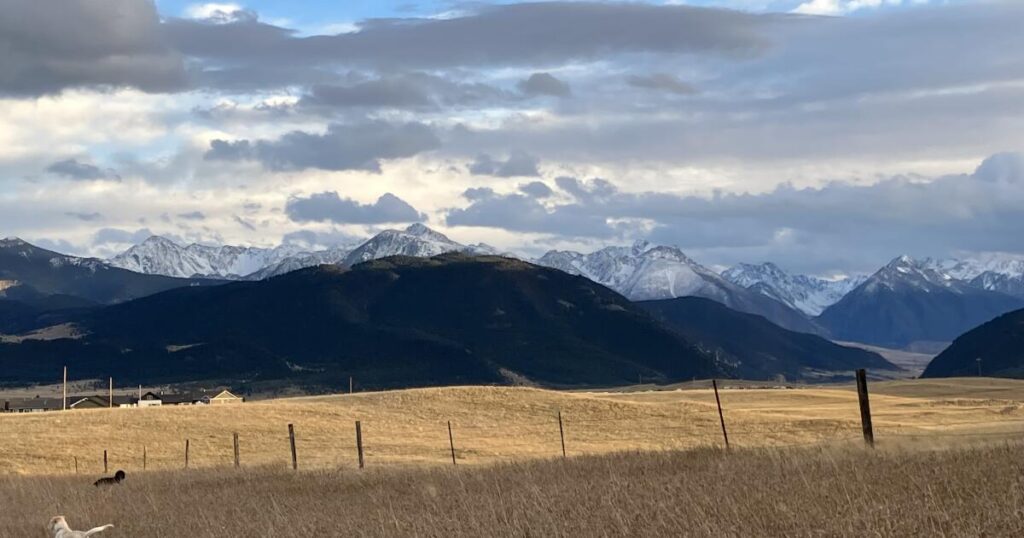[ad_1]
My version of Livingston, Mont., where I have lived since 1987, began with a kind of impoverished, artistic chain migration: My father and his best friend were writers. The best friend moved here in the late ’60s, and other friends — a painter, more writers — followed and stayed. As a teenager, I visited twice with my family and the area became a dream in the back of my head. At 27, when I decided to blow up my first career and leave New York City with a boyfriend, the painter offered us an old house for $150 a month. Livingston sounded like just the place to start again.
The romance of running away dimmed somewhere on Highway 2 in northeastern Montana. My companion studied the horizon and said, “What are you doing to me?” It was early May, and nothing was green yet, but he cheered up when the mountains appeared. As we entered town through the battered east side, passing massive, forsaken train repair buildings — the railroad had pulled out recently, obliterating hundreds of jobs in a town of 7,000 — I could have answered the question for us both: In this place you will be happy; in this place you will find it incredibly hard to make a living.
We stopped at Sax & Fryer, a newsstand and bookstore in business since 1882. The owner, John Fryer, who’d last seen me a decade earlier, gave me a kiss and handed me the key to the old house.
Livingston greened up. We blew through our tiny savings and stayed. The painter, who traded Fryer artwork for the use of offices above the store, offered me a job there. We were very lucky.
Livingston was beautiful; it was strange and cold and windy. The town is 60 miles north of Yellowstone Park, at the edge of the immense Absaroka-Beartooth Wilderness, tucked into a curve in the longest undammed river in the U.S. In 1987, the city had one of the state’s largest rodeos, a Superfund site where hazardous waste had been dumped and an end-of-the-world cult that — before the world failed to end — would build bomb shelters and bring in an armored personnel carrier.
The people who thought of themselves as local were mostly amused by the first artsy emigres, but increasingly leery of dramatic Californians and strange religions. Their default attitude wasn’t tolerance so much as a no-skin-off-my-nose belief that people would do what they wanted anyway. Nothing was stratified — you knew teachers, cooks, plumbers, ranch hands. Anyone who’d made it through the winter joined together in marveling at the summer influx. So many visitors failed to understand that anything could kill them — hot or cold water, reptiles and things with fur, the weather, gravity.
The West is dotted with towns that haven’t quite survived. Here, the first invaders from the ’60s and ’70s became part of the fabric, lifelong friends with locals like John Fryer. They went from trading paintings to owning restaurants, and they wrote scripts that brought actors to town.
Livingston has increasingly sold its idiosyncrasies: the fly-fishing, the hiking, the wild-ass bars. We’re close enough to an airport, a college, a ski hill. Thanks to people like John Fryer, who pushed to keep Livingston’s old buildings standing, the town did not wither. Instead, we have too much of a good thing. People moved here, especially during COVID, or bought up houses to list on Airbnb. What is fantastically expensive to a local seems wonderfully cheap to someone from New York or California; it was ever thus.
Some newcomers open stores and earnestly try to understand the town. They’ve replaced the funkiness but not the poverty, the drugs and alcoholism, a high suicide rate and a low minimum wage. Others complain about restaurant service without comprehending the inequality: their waiter can no longer afford to live here. A separate new sense of entitlement has less to do with wealth than the Christian right, with their own private Idaho spreading inexorably south and east from northwest Montana, where rejiggered library boards have scrubbed their shelves. We aren’t part of the white kingdom yet, but they send their best — a neo-Nazi contingent threatened drag story hours here last spring — and they’ve reawakened the people in town who share their beliefs. As historian Betsy Gaines Quammen brilliantly explains in her book “True West,” these biblical literalists believe in “the notion of Christian mastery over all living things.” They want it all, and they feel they’ve been divinely ordained.
I think I’m local now. I’ve had two kids here and drunk surreptitious margaritas at endless soccer games, worked for pennies, kayaked and filled sandbags, cooked for dozens of wakes and weddings. I’ve entered at least half of Livingston’s 20 bars, a smaller percentage of its churches. I used to like most people and feel nothing worse than indifference in return. Now I’m worried about neighbor-on-neighbor pitchforks.
John Fryer, universally beloved, died in December. His shop may close; it’s hard to profit on magazines and art supplies today. The store has seen uglier times — sedition trials after World War I and countless anti-immigrant flashpoints. The Ku Klux Klan had offices across the alley; from the painter’s rooms, you could have watched the grand dragon, a former mayor, dress up for a different kind of story hour. Over the decades, Fryer filled my novels with stories about roadhouses and brothels, Prohibition booze hidden in cemeteries, eternal land scams. He was the grandson of a Pony Express rider and an adopted member of the Crow tribe. He was a distillation of the West I moved to.
I wish I could remember more of his stories, and I wish Livingston could reclaim more of its wayward spirit, its humor and its humanity.
Jamie Harrison is the author of seven novels, including “The Center of Everything” and the forthcoming “The River View.”
[ad_2]
Source link

